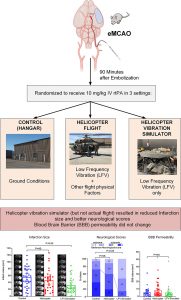
Visual overview of study
The effects of low-frequency vibrations on the efficacy of tPA in stroke patients during medical evacuation by helicopter may lead to a potential novel treatment.
Vibration was the subject of a study in Stroke, in which mice were subject to simulated medical emergency helicopter evacuation conditions and treated with either rtPA or saline, to assess the effect on thromboembolic occlusion.
The rtPA group were treated in three settings – a low-frequency vibration simulation, an actual helicopter or at ground control.
The experiment showed that animals treated in the low frequency vibration (LFV) had a reduction in infarct volume compared to the helicopter joyriders, grounded mice and control animals (31.6 v 47.8, 54.9 and 80.9 mm3).
The animals in the simulator were also more likely to have a good neurological outcome than controls (86% v 25%; OR 1.52).
The study authors said there had been concern about the effects of helicopter transport on thrombolysis outcomes and they had to conduct the experiment in animals because it would be unfeasible to do a similar tests in humans experiencing acute stroke.
They said it was surprising that receiving tPA in the helicopter did not result in smaller infarctions (47.8 versus 54.9 mm3; P=0.58) nor improve neurological outcomes (37% versus 28%; P=0.71).
There was no significant difference in blood-brain barrier permeability between the helicopter or ground LFV simulator, compared with controls.
“This is the first report of a synergistic effect between a replicated helicopter-like LFV on the ground and rtPA thrombolysis on stroke outcomes,” the investigators said.
The magnitude of this synergistic effect was substantial, with approximately half the infarct volume and triple the percentage of good neurological outcomes compared with rtPA alone.”
“Importantly, the potential negative effect of helicopter transportation on the pharmacological integrity of rtPA has been specifically ruled out.”
The study suggested that LFV provides a potential ancillary treatment strategy for patients with stroke undergoing thrombolysis.
It said LFV is omnidirectional and does not require sophisticated equipment or human expertise necessary to deliver focused energy.
“It could also be easily delivered in hospital and ambulance patient beds. Moreover, LFV is considered safe and does not raise concerns of brain cavitation. The lack of effect on BBB permeability is also reassuring.”